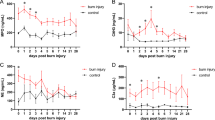Abstract
In previous studies we have demonstrated that second-degree thermal injury of skin in rats leads to secondary effects, such as systemic complement activation, C5a-mediated activation of blood neutrophils, their adhesion-molecule-guided accumulation in lung capillaries and the development of acute pulmonary injury, largely caused by neutrophil-derived toxic oxygen metabolites. In the dermal burn wound, however, pathophysiologic events are less well understood. The injury is fully developed at four hours post-burn. To further elucidate the pathogenesis of the “late phase” dermal vascular damage, rats were depleted of neutrophils or complement by pretreatment with rabbit antibody against rat neutrophils or with cobra venom factor, respectively. In other experiments, rats were treated with blocking antibodies to IL-6, IL-1, and TNFα immediately following thermal burning or were pretreated with hydroxyl radical scavengers (dimethyl sulfoxide, dimethyl thiourea). Extravasation of 125I-labeled bovine serum albumin into the burned skin was studied, as well as, skin myeloperoxidase levels. The studies revealed that, like in secondary lung injury, neutrophils and toxic oxygen metabolites, are required for full development of microvascular injury. In contrast, however, development of dermal vascular damage in thermally injured rats was not affected by complement depletion. Our data suggest that the development of microvascular injury in the dermal burn wound is complement-independent, involves the pro-inflammatory cytokines IL-1, TNFα and IL-6, and may result from reactive oxygen metabolites generated by neutrophils accumulating in the burn wound.
Similar content being viewed by others
REFERENCES
Mann, R. and D. Heimbach. 1996. Prognosis and treatment of burns. West. J. Med. 165:215–220.
Till, G. O., C. Beauchamp, D. Menpace, W. Tourtellotte Jr., R. Kunkel, K. J. Johnson, and P. A. Ward. 1983. Oxygen radical dependent lung damage following thermal injury of rat skin. J. Trauma. 23:269–273.
Mulligan, M. S., G. O. Till, C. W. Smith, D. C. Anderson, M. Miyasaka, T. Tamatani, R. F. Todd, III, T. B. Issekutz, and P. A. Ward. 1994. Role of leukocyte adhesion molecules in lung and dermal vascular injury after thermal trauma of skin. Am. J. Pathol. 144:1008–1015.
Demling, R. H. 1985. Burns. N. Engl. J. Med. 313: 1389–1398.
Freidl, H. P., G. O. Till, O. Trentz, and P. A. Ward. 1989. Roles of histamine, complement and xanthine oxidase in thermal injury of skin. Am. J. Pathol. 135:203–217.
Till, G. O., L. S. Guilds, M. Mahrougui, H. P. Freidl, O. Trentz, and P. A. Ward. 1989. Role of xanthine oxidase in thermal injury of skin. Am. J. Pathol. 135:195–202.
Till, G. O., J. R. Hatherill, W. W. Tourtellotte, M. J. Lutz, and P. A. Ward. 1985. Lipid peroxidation and acute lung injury after thermal trauma to skin: Evidence of a role for hydroxyl radical. Am. J. Pathol. 135:195–202.
Ballow, M. and C. G. Cochrane. 1969. Two anti-complementary factors in cobra venom. Hemolysis of guinea pig erythrocytes by one of them. J. Immunol. 103:944–952.
Mulligan, M. S., E. Schmid, B. Beck-Schimmer, G. O. Till, H. P. Friedl, R. B. Brauer, T. E. Hugli, M. Miyasaka, R. L. Warner, K. J. Johnson, and P. A. Ward. 1996. Requirement and role of C5a in Acute Lung Inflammatory Injury in Rats. J. Clin. Invest. 98:503–512.
Prober, J. S. and R. S. Cotran. 1990. The role of endothelial cells in inflammation. Transplantation. 50:537–544.
Bevilacqua, M. P., J. S. Prober, D. L. Mendrick, R. S. Cotran, and M. A. Gimbrone, JR. 1987. Identification of an inducible endothelial-leukocyte adhesion molecule. Proc. Natl. Acad. Sci. U.S.A. 84:9238–9242.
Bevilacqua, M. P., S. Stengelin, M. A. Gimbrone, and B. Seed. 1989. Endothelial leukocyte adhesion molecule 1: An inducible receptor for neutrophils related to complement regulatory proteins and lectins. Science 243:1160–1165.
Osborn, L., C. Hession, R. Tizard, C. Vassallo, S. Luhowskyj, G. Chi-Rosso, and R. Lobb. 1989. Direct expression cloning of vascular cell adhesion molecule 1, a cytokine-induced endothelial protein that binds to lymphocytes. Cell 60:577–584.
Dustin, M. A. and T. A. Springer. 1988. Lymphocyte function-associated antigen-1 (LFA-1) interaction with intercellular adhesion molecule-1 (ICAM-1) is one of at least three mechanisms for lymphocyte adhesion to cultures endothelial cells. J. Cell Biol. 107:321–331.
Content, J., L. De Wit, P. Poupart, G. Opdenakker, J. Van Damme, and A. Billiau. 1985. Induction of a 26-kDa-protein mRNA in human cells treated with and interleukin-1-related, leukocyte-derived factor. Eur. J. Biochem. 152:253–257.
Kasid, A., E. P. Director, and S. A. Rosenberg. 1989. Regulation of interleukin-6 (IL-6) by IL-2 and TNF-α in human peripheral blood mononuclear cells. Ann. N.Y. Acad. Sci. 557:564–566.
Maruo, N., I. Morita, M. Shirao, and S. Murota. 1992. IL-6 increases endothelial permeability in vitro. Endocrinology 131:710–714.
Biffl, W. L., E. E. Moore, F. A. Moore, V. S. Carl, F. J. Kim, and R. J. Franciose. 1994. Interleukin-6 potentiates neutrophil priming with platelet-activating factor. Arch. Surg. 129:1131–1136.
Biffl, W. L., E. E. Moore, F. A. Moore, and C. C. Barnett. 1996. Interleukin-6 delays neutrophil apoptosis via a mechanism involving platelet-activating factor. J. Trauma 40:575–579.
Mullen, P. G., A. C. J. Windsor, C. J. Walsh, A. A. Fowler, III, and H. J. Sugarman. 1995. Tumor necrosis factor-α and IL-6 selectively regulate neutrophil function in vitro. J. Surg. Res. 58:124–130.
Youker, K., C. W. Smith, D. C. Anderson, D. Miller, L. H. Michael, R. D. Rossen, and M. L. Entman. 1992. Neutrophil adherence to isolated adult cardiac myocytes: Induction by cardiac lymph collected during ischemia and reperfusion. J. Clin. Invest. 89:602–609.
Yasojima, K., K. S. Kilgore, R. A. Washington, B. R. Lucchesi, and P. L. McGeer. 1998. Complement gene expression by rabbit heart: Upregulation by ischemia and reperfusion. Circ. Res. 82:1224–1230.
Author information
Authors and Affiliations
Rights and permissions
About this article
Cite this article
Ravage, Z.B., Gomez, H.F., Czermak, B.J. et al. Mediators of Microvascular Injury in Dermal Burn Wounds. Inflammation 22, 619–629 (1998). https://doi.org/10.1023/A:1022366514847
Issue Date:
DOI: https://doi.org/10.1023/A:1022366514847




